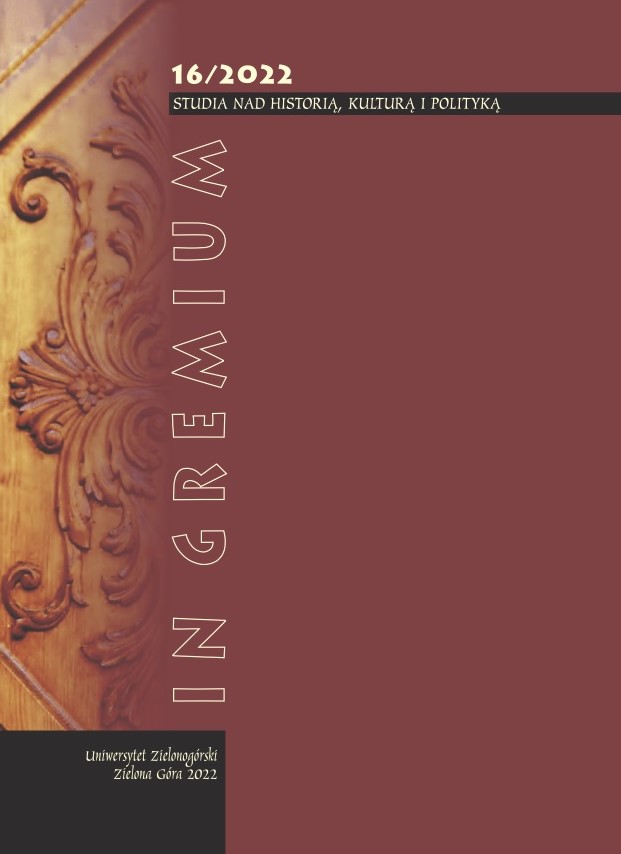Abstract
In the biography of Zenobia, the author of Historia Augusta suggested that she knew well the history of Alexandria and the East, and that she wrote an epitome about this. In this situation, there are two possibilities. Zenobia could indeed have written such a historical work, or the author of Historia Augusta attributed it to her. The author made mistakes about the names of the Queen's sons, so it is unlikely that he had any real knowledge about the Queen. There are several possible explanations as to why the author of The History of Augusta attributed to her the authorship of a historical work: it was an allusion to the seizure of Egypt by the queen's army, a reference to the work of Callinicus of Petra, or to the satires of Juwenalis. He mentioned literary works written by emperors as credible as in highly fictional works Unfortunately, neither of these hypotheses is entirely convincing.
References
Baldini A., Discendenti a Roma da Zenobia, “Zeitschrift für Papyrologie und Epigraphik”, 1978, t. 30, 145-149.
Baldini A., Echi postumi dell'usurpazione Palmirena, “Studia Palmyreńskie”.1985, 8, 141-152.
Baldwin B., Acclamations in the Historia Augusta, “Athenaeum”, 1981, t. 59, 138–149.
Banchich T. M., The History or Zonaras: From Alexander Severus to the Death of Theodosius the Great, London – N. York 2009.
Barnes T. D., Some Persons in the Historia Augusta, “Phoenix”, 1972, t. 26, 140-182.
Birley A. R., Septimius Severus: The African Emperor, London – N. York 1988.
Birley A. R., Rewriting second- and third-century history, in late antique Rome the Historia Augusta, “Classica”, 2006, t. 19, 19-29.
Bland R., The Coinage of Vabalathus and Zenobia from Antioch and Alexandria, “The Numismatic Chronicle”, 2011, t. 171, 133– 186.
Boer W. den, Some Minor Roman Historians, Leiden- Boston 1972.
Bowersock G. W., Roman Arabia, Cambridge Mass. 1994.
Burgersdijk D., Zenobia's biography in the Historia Augusta, “Talanta”, 2004-2005, t. 36-37, 139-151.
Chastagnol A., Histoire Auguste, Les empereurs romains des IIe et IIIe siècles, Paris 1994.
Edgeworth R. J., “The Death of Dido”, “The Classical Journal”, 1977, t. 72, 129–133.
Equini Schneider E., Septimia Zenobia Sebaste, Roma 1993.
Fabbini F., Paolo Orosio uno storico, Roma 1979.
Gawlikowski M., Les princes de Palmyre, “Syria”, 1985, t. 62, 251– 261.
Gawlikowski M., Odainat et Hérodien, rois des rois , “MUSJ”, 2007, t. 60, 289– 313.
Gawlikowski M., Palmyra, Warszawa 2010.
Gawlikowski M., The Portraits of the Palmyrene Royalty, w: The World of Palmyra, red. A. Kropp, R. Raja, Copenhagen 2016, 126–134.
Grant M., Mity rzymskie, Warszawa 1993.
Hartmann U., Das Palmyrenische Teilreich, Stuttgart 2001.
Janiszewski P., The Missing Link. Greek Pagan Historiography in the second half of the third century and in the fourth century AD, Warsaw 2006.
Kotula T., Aurélien et Zénobie. L’unité ou la division de l’Empire?, Wrocław 1997.
Kotula T., Aurelian i Zenobia, Wrocław 2006.
Levick B., Julia Domna, Syrian Empress, London-N. York 2007.
Opelt I., Epitome [w:] Reallexicon der Antike Christendum, nr. 5, 1962, 944-973.
Paschoud F., Histoire Auguste, T. 5, 1, Vies d’Aurélien, Tacite, Paris 1996.
Paschoud F., Zosime, Histoire Nouvelle: Tome I: Livres I Et II, Paris 2000.
Paschoud F., Histoire Auguste, T. 5, 2, Vies de Probus, Firmus, Saturnin, Proculus Et Bonose, Carus Numerien Et Carin, Paris 2001.
Paschoud F., Historie Auguste, t. 4, 3: Vies des trente tyrans et de Claude, Paris 2011.
Penella R. J., Caracalla and His Mother in the "Historia Augusta", „Historia: Zeitschrift für Alte Geschichte”, 1980, t. 29, 382-384.
Potter D. S., Prophecy and History in the Crisis of the Roman Empire, Oxford1990.
Sartre M., D'Alexandre à Zénobie: Histoire du Levant antique, IVe siècle avant J.-C.-IIIe siècle après J.-C., Paris 2001.
Sartre A., Sartre M., Zenobie: de Palmyre a Rome, Paris 2014.
Sartre A., Sartre M., Palmyre: verites et legendes, Paris 2016.
Schwartz J., L’Histoire Auguste, Suétone et Juvenal, [w:] Romanitas – Christianitas. Untersuchungen zur Geschichte und Literatur der römischen Kaiserzeit. Johannes Straub zum 70. Geburtstag gewidmet, red. G. Wirth, Berlin 1982, 634-644.
Sommer M., Palmyra: A History, London – N. York 2018.
Southern P., Empress Zenobia, Palmyra’s Rebel Queen, London – N. York 2008.
Starcky J., Gawlikowski M. Palmyre, Paris 1985.
Stein A., Kallinikos von Petrai, Hermes, nr 58, 1923, 448-456.
Stoneman R., Palmyra and its Empire: Zenobia's Revolt against Rome, Ann Arbor 1992.
Suski R., Konsolidacja Cesarstwa Rzymskiego za panowania Aureliana 270-275, Kraków 2008.
Suski R., Jowisz, Jahwe, Jezus. Religie w Historia Augusta, Warszawa 2014.
Suski R., Aluzja do rebelii Eugeniusza czy ukłon wobec aspiracji rzymskiej elity. Nowa interpretacja mowy Maeciusa Faltoniusa Nicomachusa (Hist. Aug. Tac. 6, 1-9), “Res Historica”, 2015, t. 39, 9-31.
Suski R., The Epitome – Passive Copying or a Creative Reinterpretation of the Abridged Text, Res Gestae, 2017, t. 5, 23-32.
Suski R., Kłopoty z epitome, brewiarium i Kaisergeschichte [w:] Inter Regnum et Ducatum. Studia ofiarowane Profesorowi J. Tęgowskiemu w 70 rocznicę urodzin, red. P. Guzowski, M. Liedke, K. Boroda, Białystok 2018, 535-564.
Watson A., Aurelian and the Third Century, London 1999.
Winsbury R., Zenobia of Palmyra: History, Myth and the Neo-Classical Imagination, London 2010.

